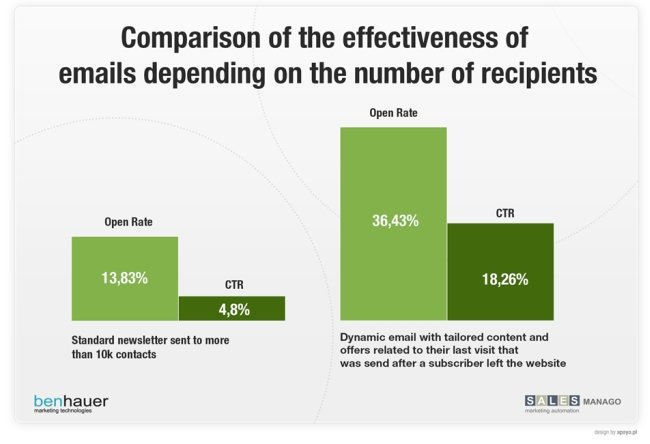Best time for sending newsletters? Optimal article length? Acceptable unsubscription rate? How to research subscribers’ preferences? Don’t look for ready-to-go solutions. Remember to think over the most important things: the aim, function, and situation in which your message will be received. Today we’re bringing you a piece of advice and a practical approach to email marketing from our partner SALESmanago.
1. How often should I send newsletters?
Send your newsletter at least once a month. Otherwise, you’ll face serious deliverability problems: your customer can forget you and his mailbox might even block your message if no interactions have been spotted. Without visible regularity, newsletters make no sense.
The best way to establish frequency is to run research or some tests. Additionally, you can offer your readers an option to change frequency preferences.
2. What’s the best time to send newsletters?
Rumour has it that Thursdays, Wednesdays, and Tuesdays are the best. There are infinite theories :
- Mondays and Fridays are close to the weekend, so people have a lot on their minds and it’s hard to get their attention
- Friday mailings have high opening and unsubscription rates, so Sundays are optimal – according to GetResponse
- Monday newsletters are most profitable – according to Experian 2012 Q4 Email Benchmark Report
- Mailings should be sent in the evening, when users are not working, relaxed, and looking for inspiring content
- Mailings should be sent in the morning before other messages arrive
Conclusion? When it comes to newsletters, speculation is not the best way to go. Run your own tests and research and adjust the sending time to the preferences of individual recipients.
3. Is there an optimal mailing day for my industry?
Even if that was true, your competitors would also know it and overwhelm your customers with their newsletters the same day you do.
4. How many articles should be covered by a single newsletter?
Common wisdom says that 3-5 is the number. However, newsletters may vary by density and content.
- Voluminous, saturated, and well-curated are sent rarely. They serve education and work well for creative businesses
- Short, specific, with a precise aim (buy a given commodity, sign up for an event) are more frequent
It takes time and research to get the balance between these two. Maybe your users will love a long, magazine-like newsletter. Or perhaps they prefer short up-to-the-point messages. In his case, make sure you don’t discourage them by sending such messages too often.
5. How much content is best for a single article?
The shorter, the better – is that really true? It’s a fact that people don’t read poor quality, uninteresting content, but they like being offered good quality. If you can deliver what they expect, you will get their attention.
The aim of your message should guide you and the length of the article depends on it. Don’t aim at brevity if it means failing to provide all the information necessary for purchase.
6. A perfect mailing, satisfying all of my readers – is it possible?
No, don’t picture your customers as a homogenous group. They have different jobs, habits, and working hours. And your mailing list is a dynamic organism with an annual loss of 25% of the addresses, so even if you found your perfect formula, it would be outdated after a year.
Go for personalization instead. Take a look at the comparison between massive mailing and dynamic 1-to-1 below.

7. Should I send my newsletter if I have nothing to say?
You should avoid doing so, but these types of situations come up every once in a while. Perhaps the business was slower or the entire team was engaged in planning a new strategy or delivering an important project.
Be prepared and keep a list of interesting but less urgent topics: These might work:
- Good texts: either new or old ever-greens
- Contests
- Survey results, customer comments arranged in the form of a chart
If these situations happen too often, consider sending newsletters less frequently.
8. What is the acceptable unsubscription rate?
No more than 1% for a good campaign.
9. How to nail the subject?
- Know your readers and personalize the subject (this makes the opening rate grow by 22,2%). To do this analyze the behaviour of your readers and run satisfaction surveys or preference tests – online surveys integrated with your newsletter are perfect for this
- Unicode
- Run A/B test
- Adjust the article length, but remember it’s not always best to make it short. Make sure you present all the key benefits
- Don’t look for magic keywords
This post has been delivered in cooperation with our partner SALESmanago. For more information visit the SALESmanago Marketing Automation website.
